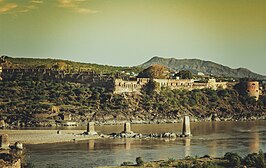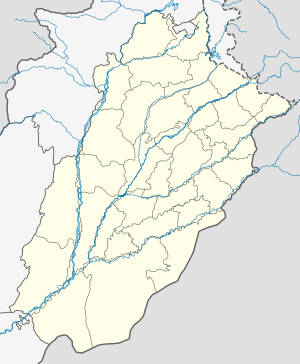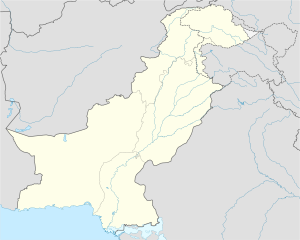|
Attock
Attock (Punjabi, Urdu: اٹک), formerly known as Campbellpur (Punjabi, Urdu: کیمبل پور),[3] is a city in Punjab, Pakistan, not far from the country's capital Islamabad. It is the headquarters of the Attock District and is 36th largest city in the Punjab and 61st largest city in the country, by population. The city was founded in 1908 several miles southeast of the historical city of Attock Khurd (Urdu: اٹک خورد:),[4] which had been established by the Mughal Emperor Akbar in the 16th century,[5] and was initially named in honour of Sir Colin Campbell.[6] EtymologyThe city was initially founded by the Mughal emperor Akbar as Atak-Banāras (Urdu: اٹک بنارس).[6] The name was changed to Campbellpur to reflect that of the Commander-in-Chief of British forces Sir Colin Campbell, who rebuilt the city.[6] The name 'Attock' was revived in 1978.[6] LanguageGeographyAttock is located east of the Indus River, 80 km (50 mi) from Rawalpindi, 100 km (62 mi) from Peshawar, and 10 km (6 mi) from the Pakistan Aeronautical Complex, Kamra. HistoryAncient periodAttock is located in the historical region of Gandhara. Alexander the Great, Mahmud of Ghazni, Timur, Nader Shah and Babur crossed the Indus at or about this spot (Attock Fort) in their invasions of India.[8] After the founding of the city by the Mughal emperor Akbar,[6] the Attock Fort was completed in 1583 under the supervision of Khawaja Shamsuddin Khawafi, a minister of Akbar.[9] During the Mughal era, Attock was part of the Lahore Subah of Punjab.[10]  Nader Shah crossed through Attock when he defeated the Mughals at the Battle of Karnal and thus ended Mughal power in Northern India. The Battle of Attock took place at Attock Khurd on 28 April 1758, between the Durrani state and Maratha Empire. The Marathas under Raghunathrao Ballal Peshwa and Tukojirao Holkar Bahadur were victorious in the battle and Attock was captured.[11] But this conquest was short-lived as Ahmad Shah Durrani came in person to recapture Attock and checked the Maratha advance after destroying their forces at Panipat. After the decline of the Durrani state, the Sikhs invaded and occupied Attock District. The Sikh Kingdom (1799–1849) under Ranjit Singh (1780–1839) captured the fortress of Attock in 1813 from the Durrani Nawab[citation needed]. After the occupation of Kashmir by Sikh Kingdom in 1820 many Kashmiris migrated to the plains of Attock. In February 1849, Attock Khurd (Old Attock) was conquered by the British East India Company who created Campbellpur District. Following the Indian Rebellion in 1857, the region's strategic value was appreciated by the British, who established the Campbellpur Cantonment in 1857–58.[4] Modern PeriodThe Campbellpur Cantonment was established by the British colonial rulers in 1858. Campbellpur District was organised in 1904,[4] by the division of Talagang Tehsil in the Jhelum District with the Pindigheb, Fateh Jang and Attock tehsils from Rawalpindi District. Today the Attock district consists of six tehsils: Fateh Jang, Hazro, Hasan Abdal, Jand, and Pindi Gheb. The city's foundations were laid in 1908 and the city was named after Sir Colin Campbell, British Commander-in-Chief of India.[4] The old city was established near the 16th century near the Attock fort that had guarded the major routes between Central Asia and South Asia. Attock's first oil well was drilled in Khaur in 1915,[12] while the Attock Oil Company was established[13] with a selling arrangement with the Burmah Oil Company. During 1928, the region produced 350,000 barrels of oil.[14] Attock was one of the northernmost points of the Punjab Province of British India prior to the partition; it thus found itself being a part of the common Hindi-Urdu phrase used to describe the length of colonial India: "Attock se Cuttack" (from Attock to Cuttack). The term "Attock se Cuttack" was first used to describe the extent of the Maratha Empire after they conquered Cuttack in 1750 and Attock in 1758.[15] After the independence of Pakistan in 1947, Hindu and Sikh minorities emigrated to India, while Muslim refugees from India settled in Attock. The Government of Pakistan renamed Campbellpur as Attock in 1978.[5] The city and surrounding area are known for their high representation among soldiers of the Pakistan Army.[16] EducationAccording to the Alif Ailaan Pakistan District Education Rankings 2019, Attock is ranked 3 out of 146 districts of Pakistan in terms of the quality of education. For facilities and infrastructure, the district is ranked 17 out of 146.[17] A detailed picture of the district's education performance is also available online.[18]
Institutions include:- Fazaia Degree College, Attock, Government Graduate College, Attock, Government College for Women, Attock, Allied School, Attock, FG Public High School, University of Education Attock Campus, Fazaia Inter College, Army Public School & College, Attock, Government Polytechnic Institute, Attock,[19] Beacon Light English Model Secondary School,[20] COMSATS University Islamabad, Air University Aerospace and Aviation Campus Kamra and Punjab College, Attock Notable peopleClimateAttock has a humid subtropical climate (Köppen: Cwa) which has hot and humid summers, and cold to mild winters. Sports
See also
References
|
||||||||||||||||||||||||||||||||||||||||||||||||





